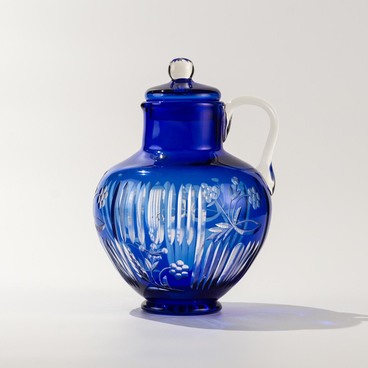A pitcher is one of the oldest types of vessels. It is a container for drinks with a clearly defined neck and handle. Our ancestors used it for storing and serving liquids, for washing, and for conducting church rituals. Sometimes, pitchers were even used for church construction as resonators: they were embedded into the base of the dome along its entire circumference so that only their openings were exposed to absorb the echo. Pitchers can have various shapes, including round, cone-shaped, ovoid, and cylindric. Usually, they have a flat bottom, sometimes — a short stem. In Russian, a cylindric pitcher with a lid can be called a “zhban”, and a special kvass pitcher — a “kvassnik”. In the 18th century, Russian and German artists made pitchers which had a special section for ice inside. This is the case with the pitcher from the museum collection.
The pitcher was made of colorless glass mass, using exclusively the free blowing technique where the glass is processed immediately at the glass melting furnace. At first, the craftsman blows the body of a pitcher. Later, it is picked up by a special tool — a punty — and an additional gather of glass mass is used to make the section for ice and the handle.
In Russian, this technique is known as “gutnaya”. There are two versions of the etymology: it is likely that the term originated from the Old High German word die Hütte (which means “a cabin”, “a hut”, or “metalworks”), or from an even older Latin word “gutta” (which means “a drop”, in this case — a drop of hot glass mass) or “gutturnium” (“pouring out a liquid drop by drop”).
The special section inside the pitcher was intended for ice. This is exactly how such items were named in the early-20th-century price lists of the Dyatkovo Crystal Factory: “a pitcher with a section for ice”. Back then, such a pitcher cost 2 rubles and 80 kopecks. Although difficult to make, the pitchers were mass produced. Being convenient and practical, they were of great use in a time when there were no refrigerators, helping to keep drinks cold in summer. Ice was prepared beforehand and stored in deep ice cellars. It could be placed inside the special section of the pitcher without risking spoiling the taste of the drink: being completely isolated from the main volume of the pitcher, it did not mix with the drink when melting.
The pitcher was made of colorless glass mass, using exclusively the free blowing technique where the glass is processed immediately at the glass melting furnace. At first, the craftsman blows the body of a pitcher. Later, it is picked up by a special tool — a punty — and an additional gather of glass mass is used to make the section for ice and the handle.
In Russian, this technique is known as “gutnaya”. There are two versions of the etymology: it is likely that the term originated from the Old High German word die Hütte (which means “a cabin”, “a hut”, or “metalworks”), or from an even older Latin word “gutta” (which means “a drop”, in this case — a drop of hot glass mass) or “gutturnium” (“pouring out a liquid drop by drop”).
The special section inside the pitcher was intended for ice. This is exactly how such items were named in the early-20th-century price lists of the Dyatkovo Crystal Factory: “a pitcher with a section for ice”. Back then, such a pitcher cost 2 rubles and 80 kopecks. Although difficult to make, the pitchers were mass produced. Being convenient and practical, they were of great use in a time when there were no refrigerators, helping to keep drinks cold in summer. Ice was prepared beforehand and stored in deep ice cellars. It could be placed inside the special section of the pitcher without risking spoiling the taste of the drink: being completely isolated from the main volume of the pitcher, it did not mix with the drink when melting.


